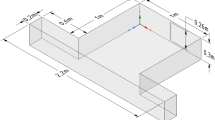Abstract
This paper studies approaches to numerical modeling of the transfer of harmful gas emission from low sources in the vicinity of the highways. A model problem of ethane injection through a system of low sources located on a flat plate imitating a road is considered as applied to experimental data of [22]. The influence of the turbulent Schmidt number on the processes of turbulent mixing of gases in the vicinity of a system of bluff bodies is investigated. Within the framework of numerical modeling, various configurations of barrier location in the vicinity of highways are considered and the most effective configurations are estimated in terms of air quality in pedestrian zones. A qualitative and quantitative comparison with experimental data on the profiles of ethane concentration in characteristic locations is carried out.
Similar content being viewed by others
References
E.Yu. Bezuglaya, E.K. Zavadskaya, T.P. Ivleva, I.V. Smirnova, and I.A. Vorobyova, Air quality in the largest Russian cities for 10 years from 1998 to 2007. Analytical review. SI “MGO” Rosgidromet, 2009.
National center for atmospheric research: atmospheric chemistry observations and modeling: [website]. URL: https://www2.acom.ucar.edu/wrf-chem.
ASHRAE Handbook — HVAC Applications, American Society of Heating Refrigerating and Air-Conditioning Engineers, 2011.
D.J. Wilson, Critical wind speeds for maximum exhaust gas reentry from flush vents at roof level intakes, ASHRAE Trans., 1982, Vol. 88, P. 503–513.
D.J. Wilson, A design procedure for estimating air intake contamination from nearby exhaust vents, ASHRAE Trans., 1983, Vol. 89, P. 136–152.
B. Blocken, T. Stathopoulus, P. Saathoff, and X. Wang, Numerical evaluation of pollutant dispersion in the built environment: comparisons between models and experiments, J. Wind Eng. Ind. Aerodyn., 2008, Vol. 96, No. 10–11, P. 1817–1831.
C. Gromke, A vegetation modeling concept for building and environmental aerodynamics wind tunnel tests and its application in pollutant dispersion studies, Environ. Pollut., 2011, Vol. 159, No. 8–9, P. 2094–2009.
A.V. Starchenko, R.B. Nuterman, and E.A. Danilkin, Numerical Simulation of Turbulent Flows and Admixture Transfer in Street Canyons, TSU Publishers, Tomsk, 2015.
A. Alonso-Estébanez, A. Pascual-Muṅoz, C. Yagüe et al., Field experimental study of traffic-induced turbulence on highways, Atmos. Environ., 2012, Vol. 61, P. 189–196.
D. Bäumer, B. Vogel, and F. Fiedler, A new parameterisation of motorway-induced turbulence and its application in a numerical model, Atmos. Environ., 2005, Vol. 39, No. 31 (Spec. ISS), P. 5750–5759.
S. Valger and N. Fedorova, Numerical simulation of multicomponent gas flow in vicinity of bluff body within non-isothermal boundary layer, AIP Conf. Proc., 2018, Vol. 2027, No. 1, P. 040043–1–040043–8.
S.A. Valger, N.N. Fedorova, and A.V. Fedorov, Structure of turbulent separated flow in the neighborhood of a plate-mounted prism of square section, Thermophysics and Aeromechanics, 2015, Vol. 22, No. 1, P. 29–41.
C. Gromke and B. Ruck, Pollutant concentrations in street canyons of different aspect ratio with avenues of trees for various wind directions, Boundary-Layer Meteorol., 2012, Vol. 144, No. 1, P. 41–64.
Y. Tominaga and T. Stathopoulos, Turbulent schmidt numbers for CFD analysis with various types of flow field, Atmos. Environ., 2007, Vol. 41, No. 37, P. 8091–8099.
M.G. Snyder, A. Venkatram, and D.K. Heist, RLINE: a line source dispersion model for near-surface releases, Atmos. Environ., 2013, Vol. 77, P. 748–756.
C.W. Milando and S.A. Batterman, Operational evaluation of the RLINE dispersion model for studies of traffic-related air pollutants, Atmos. Environ., 2018, Vol. 182, P. 213–224.
F.E. Ahangar, D. Heist, S. Perry, and A. Venkatram, Reduction of air pollution levels downwind of a road with an upwind noise barrier, Atmos. Environ., 2017, Vol. 155, P. 1–10.
A. Venkatram and T.W. Horst, Approximating dispersion from a finite line source, Atmos. Environ., 2006, Vol. 40, No. 13, P. 2401–2408.
P. Gousseau, B.J.E. Blocken, T. Stathopoulus, and G.J.F. van Heijst, Near-field pollutant dispersion in an actual urban area: analysis of the mass transport mechanism by high-resolution large eddy simulations, Comput. Fluids, 2015, Vol. 114, P. 151–162.
J.T. Steffens, D.K. Heist, S.G. Perry, V. Isakov et al., Effects of roadway configurations on near-road air quality and the implications on roadway designs, Atmos. Environ., 2014, Vol. 94, P. 74–85.
K. Ahmad, M. Khare, and K.K. Chaudhry, Wind tunnel simulation studies on dispersion at urban street canyons and intersections — a review, J. Wind Eng. Ind. Aerodyn., 2005, Vol. 93, No. 9, P. 697–717.
D.K. Heist, S.G. Perry, and L.A. Brixey, A wind tunnel study of the effect of roadway configurations on the dispersion of traffic-related pollution, Atmos. Environ., 2009, Vol. 43, No. 32, P. 5101–5111.
J. Shin, D. Han, and H. Sung, Modeling of aluminum combustion in air-breathing combustor, 5th Eur. Conf. Aerosp. Sci., 2013, P. 2–4.
ANSYS Fluent Theory Guide, ANSYS Inc., USA, 2020.
R. Ramponi and B. Blocken, CFD simulation of cross-ventilation for a generic isolated building: Impact of computational parameters, Build. Environ., 2012, Vol. 53, P. 34–48.
J. Franke, C. Hirsch, A.G. Jensen, H.W. Krüs et al., The COST 732 best practice guideline for CFD simulation of flows in the urban environment: a summary, Inter. J. Environ. Pollut., 2011, Vol. 44, Nos. 1–4, P. 419–427.
P.J. Richards and R.P. Hoxey, Appropriate boundary conditions for computational wind engineering models using the k-ε turbulence model, J. Wind Eng. Ind. Aerodyn., 1993, Vol. 46–47, P. 145–153.
Z.J. Chen and A.J. Przekwas, A coupled pressure-based computational method for incompressible/compressible flows, J. Comput. Phys., 2010, Vol. 229, No. 24, P. 9150–9165.
Author information
Authors and Affiliations
Corresponding authors
Additional information
The work was financially supported by the Russian Foundation for Basic Research (Grant No. 18-08-00755 A).
Rights and permissions
About this article
Cite this article
Lavruk, S.A., Valger, S.A. The effect of barrier location on characteristics of gas pollutant transfer in the vicinity of highway. Thermophys. Aeromech. 28, 369–381 (2021). https://doi.org/10.1134/S0869864321030070
Received:
Revised:
Accepted:
Published:
Issue Date:
DOI: https://doi.org/10.1134/S0869864321030070




